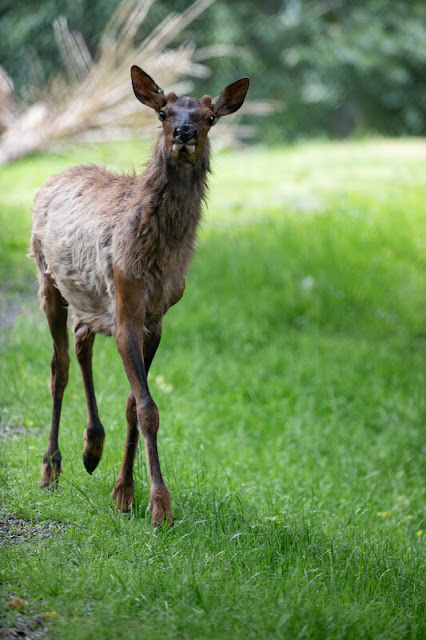Posted by Gigi Allianic, Communications
Photos: Jeremy Dwyer-Lindgren/Woodland Park Zoo
 |
| Huckleberry and Holly are half-siblings. |
Woodland Park Zoo’s herd of elk just got bigger with the addition of a new male, Huckleberry, and female, Holly. Both elk, who are half-siblings, were born at Dakota Zoo in Bismarck, N.D. Both will turn 1 year old this summer. The new elk bring the herd to a total of five individuals. In addition to Huckleberry and Holly, the zoo is home to females Lily, Willow and Buttons. Last summer, the zoo mourned the loss of its only male elk, Goodwyn (good-win), who died at 20 years old due to geriatric-related issues.
 |
| For now, Holly and her half-brother are smaller than the other elk in the herd. But they still have some growing to do! |
“We’re very fortunate to grow our herd so visitors to Woodland Park Zoo can learn about natural elk behavior and see how they socialize. After losing our sole male, Goodwyn, last summer, we’re back to a natural grouping with the addition of a new male,” said Pat Owen, an animal care manager at Woodland Park Zoo. “Huckleberry and Holly appear calm and confident. Although the male is young, Huckleberry is already presenting behavior like a bull both in his posture and attempts to dominate the cows, that is until they put him in his place.”
 |
| Huckleberry and Holly are getting to know all the members of their herd. |
The expansive elk meadow in the zoo’s Living Northwest Trail is designed to offer visitors an opportunity to view wolves in the foreground to help teach visitors about the critical predator-prey relationship between elk and wolves in their natural habitat.
Two subspecies of elk range in Washington state: Roosevelt elk, which are primarily on the west side of the Cascades, and Rocky Mountain elk, which are primarily on the east side. Huckleberry, Holly, and Buttons are Rocky Mountain and Lily and Willow are Roosevelt.
 |
| Buttons is 10 years old. She joined our herd several years ago after humans—believing she was orphaned—began feeding her. Her story is a great reminder of the need to let wildlife stay wild. |
Buttons came to Woodland Park Zoo from the wild after gaining notoriety several years ago in the area between Ellensburg and Cle Elum where residents—believing she was orphaned—began feeding her, petting her and even putting kids onto her back. For her safety and the community, Washington Department of Fish and Wildlife biologists tried relocating Buttons to a more remote area, but she wasn’t able to integrate with the wild elk herds; in 2019 Woodland Park Zoo became her new home. Her story is a great reminder of the need to coexist safely with wildlife and to let wild animals remain wild.
 |
| Handsome Huckleberry—who will be 1 year old this summer—is just beginning to grow antlers, which look like nubs right now. |
Woodland Park Zoo advocates for and saves species and spaces around the Pacific Northwest through its
Living Northwest Program, including western pond turtles, wolves, wolverines and many others. The recently reimagined Living Northwest Trail exhibit is home to the zoo’s elk, Canada lynx, brown bears, snowy owls and other native wildlife. The exhibit and its companion website,
“We Are Living Northwest,” provide visitors with numerous conservation actions to help the species that share the region’s iconic landscapes. You can share how you are living Northwest using #IAmLivingNorthwest on social media!
We hope you'll come visit the new elk and the whole herd!





Comments
Post a Comment